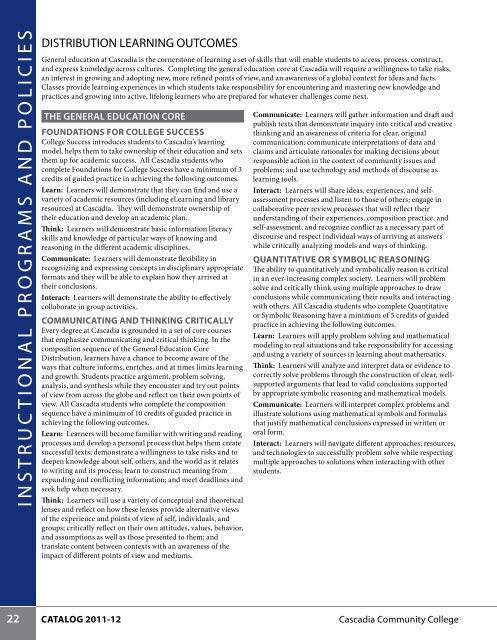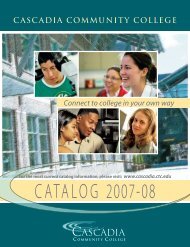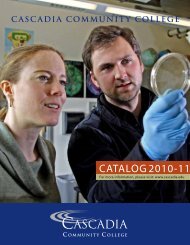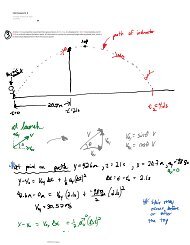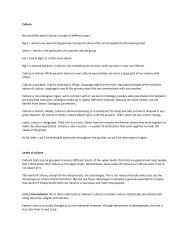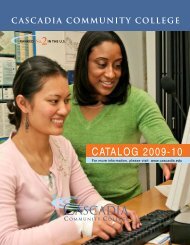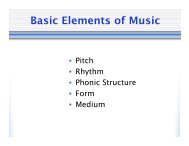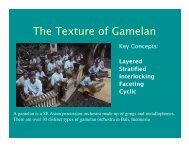2011-12 CATALOG - Cascadia Community College
2011-12 CATALOG - Cascadia Community College
2011-12 CATALOG - Cascadia Community College
You also want an ePaper? Increase the reach of your titles
YUMPU automatically turns print PDFs into web optimized ePapers that Google loves.
Instructional Programs AND Policies<br />
DISTRIBUTION Learning Outcomes<br />
General education at <strong>Cascadia</strong> is the cornerstone of learning a set of skills that will enable students to access, process, construct,<br />
and express knowledge across cultures. Completing the general education core at <strong>Cascadia</strong> will require a willingness to take risks,<br />
an interest in growing and adopting new, more refined points of view, and an awareness of a global context for ideas and facts.<br />
Classes provide learning experiences in which students take responsibility for encountering and mastering new knowledge and<br />
practices and growing into active, lifelong learners who are prepared for whatever challenges come next.<br />
The General Education Core<br />
Foundations for <strong>College</strong> Success<br />
<strong>College</strong> Success introduces students to <strong>Cascadia</strong>’s learning<br />
model, helps them to take ownership of their education and sets<br />
them up for academic success. All <strong>Cascadia</strong> students who<br />
complete Foundations for <strong>College</strong> Success have a minimum of 3<br />
credits of guided practice in achieving the following outcomes.<br />
Learn: Learners will demonstrate that they can find and use a<br />
variety of academic resources (including eLearning and library<br />
resources) at <strong>Cascadia</strong>. They will demonstrate ownership of<br />
their education and develop an academic plan.<br />
Think: Learners will demonstrate basic information literacy<br />
skills and knowledge of particular ways of knowing and<br />
reasoning in the different academic disciplines.<br />
Communicate: Learners will demonstrate flexibility in<br />
recognizing and expressing concepts in disciplinary appropriate<br />
formats and they will be able to explain how they arrived at<br />
their conclusions.<br />
Interact: Learners will demonstrate the ability to effectively<br />
collaborate in group activities.<br />
Communicating and Thinking Critically<br />
Every degree at <strong>Cascadia</strong> is grounded in a set of core courses<br />
that emphasize communicating and critical thinking. In the<br />
composition sequence of the General Education Core<br />
Distribution, learners have a chance to become aware of the<br />
ways that culture informs, enriches, and at times limits learning<br />
and growth. Students practice argument, problem solving,<br />
analysis, and synthesis while they encounter and try out points<br />
of view from across the globe and reflect on their own points of<br />
view. All <strong>Cascadia</strong> students who complete the composition<br />
sequence have a minimum of 10 credits of guided practice in<br />
achieving the following outcomes.<br />
Learn: Learners will become familiar with writing and reading<br />
processes and develop a personal process that helps them create<br />
successful texts; demonstrate a willingness to take risks and to<br />
deepen knowledge about self, others, and the world as it relates<br />
to writing and its process; learn to construct meaning from<br />
expanding and conflicting information; and meet deadlines and<br />
seek help when necessary.<br />
Think: Learners will use a variety of conceptual and theoretical<br />
lenses and reflect on how these lenses provide alternative views<br />
of the experience and points of view of self, individuals, and<br />
groups; critically reflect on their own attitudes, values, behavior,<br />
and assumptions as well as those presented to them; and<br />
translate content between contexts with an awareness of the<br />
impact of different points of view and mediums.<br />
Communicate: Learners will gather information and draft and<br />
publish texts that demonstrate inquiry into critical and creative<br />
thinking and an awareness of criteria for clear, original<br />
communication; communicate interpretations of data and<br />
claims and articulate rationales for making decisions about<br />
responsible action in the context of community issues and<br />
problems; and use technology and methods of discourse as<br />
learning tools.<br />
Interact: Learners will share ideas, experiences, and selfassessment<br />
processes and listen to those of others; engage in<br />
collaborative peer review processes that will reflect their<br />
understanding of their experiences, composition practice, and<br />
self-assessment; and recognize conflict as a necessary part of<br />
discourse and respect individual ways of arriving at answers<br />
while critically analyzing models and ways of thinking.<br />
Quantitative or Symbolic Reasoning<br />
The ability to quantitatively and symbolically reason is critical<br />
in an ever-increasing complex society. Learners will problem<br />
solve and critically think using multiple approaches to draw<br />
conclusions while communicating their results and interacting<br />
with others. All <strong>Cascadia</strong> students who complete Quantitative<br />
or Symbolic Reasoning have a minimum of 5 credits of guided<br />
practice in achieving the following outcomes.<br />
Learn: Learners will apply problem solving and mathematical<br />
modeling to real situations and take responsibility for accessing<br />
and using a variety of sources in learning about mathematics.<br />
Think: Learners will analyze and interpret data or evidence to<br />
correctly solve problems through the construction of clear, wellsupported<br />
arguments that lead to valid conclusions supported<br />
by appropriate symbolic reasoning and mathematical models.<br />
Communicate: Learners will interpret complex problems and<br />
illustrate solutions using mathematical symbols and formulas<br />
that justify mathematical conclusions expressed in written or<br />
oral form.<br />
Interact: Learners will navigate different approaches, resources,<br />
and technologies to successfully problem solve while respecting<br />
multiple approaches to solutions when interacting with other<br />
students.<br />
22 Catalog <strong>2011</strong>-<strong>12</strong> <strong>Cascadia</strong> <strong>Community</strong> <strong>College</strong>


